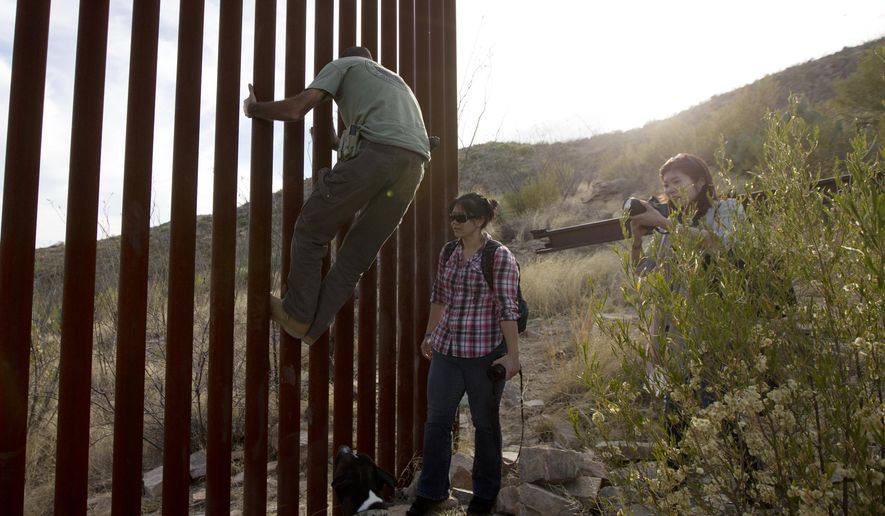President Trump’s border wall will not stretch all the way from the Gulf of Mexico to the Pacific Ocean, Homeland Security Secretary John F. Kelly said Wednesday, for the first time putting some limits on the length of the barrier that he is beginning to build.
“It’s unlikely we will build a wall or physical barrier from sea to shining sea,” Mr. Kelly told the Senate Homeland Security and Governmental Affairs Committee, which has been probing advances in border security and Mr. Trump’s proposed wall.
Prototype designs for the wall were due Tuesday night, and the next step is for the government to pick out winners and have them build test sections, which Homeland Security officials will test to see whether they can withstand breach attempts and deter climbers.
The department asked for prototypes to be 30 feet high, but Mr. Kelly said he is not sure what the eventual size will be, nor what it will look like.
Mr. Kelly said because he doesn’t know what the wall will look like nor how much will be built, he can’t predict the cost. But he shot down speculation that the entire southwest border would be blocked.
Mr. Trump suggested during the election campaign last year that the wall would go along the border, but Mr. Kelly said he is sure the president will take his recommendation.
SEE ALSO: Illegal immigration down 67 percent under Donald Trump: Former commissioner
Sen. Claire McCaskill, Missouri Democrat, said Mr. Trump’s brash assertion of a complete border wall has soured Congress on the plans. If the president would acknowledge Mr. Kelly’s lower target, she said, it would improve the debate.
“You get it, we all get it. But the president is so stubborn,” she said.
The U.S.-Mexico border stretches about 1,950 miles. Of that, just 354 miles have a fence. Another 300 miles have barriers designed to stop vehicles but won’t stop people on foot.
Congress has repeatedly voted to build more fencing, including most recently a 2013 vote in the Senate to add 350 more miles of fencing. That vote, which was part of that year’s failed immigration bill, earned the support of every Democrat in the chamber at that time.
But both Republicans and Democrats are now questioning the scope of Mr. Trump’s plans and wondering whether walls will be worth the cost.
Those questions have intensified as it has become clear that illegal immigration is dropping dramatically under Mr. Trump, even before the first mile of wall is added.
The Homeland Security Department said this week that apprehensions along the southwest border — a rough yardstick for the overall flow of migrants — are down a stunning 72 percent since December. The number of unaccompanied children and families, which surged under President Obama, is down 91 percent.
Just as stunning was a drop in the number of illegal immigrant Haitians who had been showing up at ports of entry and demanding to be let in. Last year, they were coming at a rate of more than 3,500 a month, enticed by what analysts said was a lax enforcement policy. In March, just 100 showed up.
“Today’s announcement of the dramatic drop in illegal southern border apprehensions demonstrates that the president’s commitment to securing our border and supporting law enforcement is already showing results,” White House press secretary Sean Spicer said.
Homeland Security also released its third weekly name-and-shame report on sanctuary cities Wednesday, identifying some 65 more immigrants who were released from prisons and jails rather than turned over to U.S. Immigration and Customs Enforcement officers for deportation.
Drunken driving and assault charges were the most common on the list, but Philadelphia released a Mexican charged with making a terrorist threat, and Santa Fe, New Mexico, released a Mexican convicted of contributing to the delinquency of a minor.
The number of jurisdictions deemed sanctuaries dropped from 151 last week to 146 on the list this week. ICE officials said they are continuously updating the list with tips from the public and with information from cities and counties that say their policies have changed or don’t qualify.
During Wednesday’s hearing, Mr. Kelly faced resistance from Democrats who worried that his deportation officers and agents are casting too wide a net.
Sen. Kamala D. Harris, California Democrat, prodded Mr. Kelly to explain how agents are to use the priorities list he released, replacing the Obama administration’s more narrow list.
The Obama administration had a three-tier list and told agents that they should pursue illegal immigrants at the higher priorities.
Mr. Kelly’s list has seven priorities, and he said they aren’t ranked in order — agents should feel free to try to deport any illegal immigrant who in the agents’ judgment meets a priority category.
“The direction they have is the start point is illegal status, then something from the priorities,” he said.
Mr. Kelly also shot down fears that he would separate mothers from their children when they are caught at the border, saying that will happen only in extreme circumstances in which the mother is a drug addict or otherwise a potential danger to her family.
• Stephen Dinan can be reached at sdinan@washingtontimes.com.




Please read our comment policy before commenting.